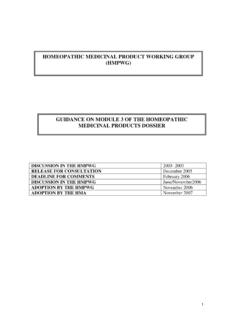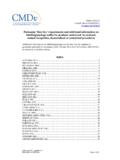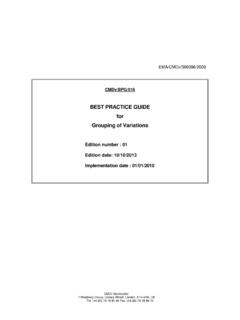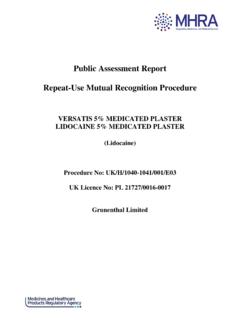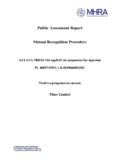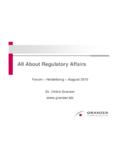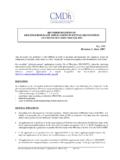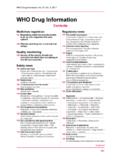Transcription of CMD(h) BEST PRACTICE GUIDE ON THE PROCESSING OF …
1 BPG on the PROCESSING of Renewals in the mutual recognition and decentralised procedures , November 2008 Page 1/11 CMD(h) BEST PRACTICE GUIDE ON THE PROCESSING OF RENEWALS IN THE mutual recognition AND decentralised procedures CMDh/004/ November 2008 1. INTRODUCTION This paper considers issues associated with the PROCESSING of renewals in the mutual recognition and decentralised procedures , with an aim of giving procedural advice to assist member states and applicants, in order to ensure a consistent and beneficial approach to renewal. 2. LEGAL FRAMEWORK In accordance with Article 24 of Directive 2001/83/EC, as amended, a marketing authorisation may be renewed after 5 years on the basis of a re-evaluation of the risk:benefit balance by the competent authority of the authorising member state. Once renewed, the marketing authorisation shall be valid for an unlimited period unless the competent authority decides, on justified grounds relating to pharmacovigilance, to proceed with one additional five-year renewal.
2 The marketing authorisation holder shall provide the competent authority with a consolidated version of the file in respect of quality, safety and efficacy including all variations introduced since the marketing authorisation was granted at least 6 months before expiry of the marketing authorisation. With the approval of the reference Member State and concerned Member States, certain changes to the marketing authorisation particulars may be made at renewal, and these changes shall not trigger a variation procedure. Further details of permitted changes are given in Section Assessment Process. However, none of the SPC changes introduced at renewal should substitute for the marketing authorisation holder obligation to update the marketing authorisation throughout the life of the product by variation procedure as data emerge. 3. PRINCIPLES OF SUBMISSION AND EVALUATION Date for renewal For the mutual recognition procedure a common renewal date should be agreed by the member states and the applicant.
3 Flexibility will be maintained as to the basis of the renewal date and will take account of the applicant's preference in agreeing a common renewal date for all presentations of the actual product, the International Birth Date and/or the European Birth Date, and the maintenance of synchronisation of PSURs. The marketing authorisation holder should agree the common renewal date with the reference Member State at the completion of the initial mutual recognition procedure (in PRACTICE this should be within 30 days of Day 90). BPG on the PROCESSING of Renewals in the mutual recognition and decentralised procedures , November 2008 Page 2/11 The principle applies that the marketing authorisation holder may apply for a renewal earlier than 5 years, but the period before application may not extend beyond 5 years. Submission therefore will be based on the earliest renewal date in any one member state, unless the marketing authorisation holder agrees an alternative date with the reference Member State.
4 For example, an optional procedure to synchronise renewal dates between member states or for all presentations of the same product is detailed in Section In PRACTICE this may mean the period between authorisation and renewal will be less than 5 years in concerned member states. An option is to fix the renewal date on Day 90 of the mutual recognition procedure for medicinal products approved through the mutual recognition process, and apply for early renewal of the reference Member State product using the optional procedure. For those products already licensed nationally via a harmonising procedure, agreement should be sought on a common renewal date. For repeat mutual recognition procedures , so called repeat use procedures , the renewal timetable should follow that of the first procedure. For products authorised through the decentralised procedure the common renewal date should be agreed on completion of the procedure (in PRACTICE within 30 days of end of procedure) In addition, in order to put in place measures facilitating work-sharing of PSUR assessment among competent authorities, a harmonisation of the renewal dates and/or PSUR cycles of medicinal products containing the same active substances may be proposed by the Marketing Authorisations Holders or the competent authorities.
5 Optional procedure for earlier renewal For medicinal products, which have benefited from mutual recognition , there are advantages in having a common renewal date in all concerned Member States for the one 5-year renewal. Therefore, the following procedure has been set out. It must be stressed that this is an optional procedure, to be followed on a voluntary basis by the marketing authorisation holder and Member States a. At the end of the 90 day European phase in the mutual recognition procedure, the basis for a mutually recognised product will have been agreed and concerned Member States will grant a marketing authorisation for a period of 5 years. The marketing authorisation in the concerned Member States will therefore have the same renewal date. b. The mutually recognised product in the reference Member State may be renewed immediately afterwards, ahead of the usual 5 year renewal date on the basis of the agreed SPC and any minor changes arising from mutual recognition discussions.
6 This change of renewal date would be a voluntary request by the marketing authorisation holder to the reference Member State. c. A PSUR will not normally be required at this time. d. In the event of a repeat use of the mutual recognition procedure, that is when the mutual recognition procedure is used more than once for subsequent applications to other Member States in relation to the same medicinal product, the marketing authorisation holder could apply for a renewal earlier than the 5 years, in order to get the renewal dates synchronised with the date in the reference Member State. BPG on the PROCESSING of Renewals in the mutual recognition and decentralised procedures , November 2008 Page 3/11 Date for submission The applicant submits the renewal application simultaneously to all concerned Member States. The renewal submission is required no later than 6 months before the expiry date. Timetable Member States have agreed the need for a timetable approach to renewals.
7 The use of a preliminary assessment report as well as a finalised assessment report, and a clock off period, will allow Member States to input to the renewal process as required and give companies the opportunity to resolve issues within the renewal process. A 90 day procedure is followed using the Type II variation model, with the possibility of clock-off for no more than 30 days to allow for the applicant to provide the responses required. In exceptional circumstances only, and with agreement of the reference Member State, the clock-off period may be extended. A timetable is given at Annex 1. The reference Member State takes the lead in the procedure and circulates the timetable (see Annex 1) Documents to submit A consolidated version of the file is requested consisting of the documents listed in Annex 2. Renewal applications should be submitted using the EU-CTD format.
8 It is recommended that MA holders take the opportunity to reformat the quality part of the dossier (Module 3) into CTD-format and, although it will not be obligatory until 2009, provide this in electronic format (please refer to NTA CTD Questions and Answers no 2). The European renewal application form should be completed. The form is available in the Notice to Applicants (Volume 2C) at #2c. The marketing authorisation holder normally should submit one renewal application form for each marketing authorisation. If a revised SPC, labelling and/or package leaflet (PL) is proposed to take account of issues raised by the expert, the precise present and proposed wording should be specified on the form. Alternatively such listing may be provided as a separate document attached to the application form under a tabular format (indicating the current and proposed texts). Any changes not listed will not be considered as part of the renewal application.
9 In general, proposed amendments to the SPC should be discussed and agreed with the reference Member State in advance of submission. The renewal application form also incorporates a declaration to be signed that the quality of the product, in respect of the methods of preparation and control, has been regularly updated by variation procedure to take account of technical and scientific progress, and that the product conforms with current CHMP quality guidelines. The marketing authorisation holder is responsible for ensuring that the dossier is kept up to date throughout the life of the product by way of the variation process. Periodic Safety Update Reports (PSURs): Reference should be made to Volume 9 of the Rules Governing Medicinal Products in the European Union on Pharmacovigilance (Notice to Marketing Authorisation Holders). In accordance with the Notice to Applicants the following principles should be taken into account: BPG on the PROCESSING of Renewals in the mutual recognition and decentralised procedures , November 2008 Page 4/11 The marketing authorisation holder should submit the renewal application at least 6 months before the expiry of the marketing authorisation in the EU.
10 This may be submitted earlier in order to facilitate co-ordination with the regular cycle of the PSUR. The PSUR should be submitted within 60 days of the last data lock point (DLP). Marketing authorisation holders should lock their data no more than 60 days before submitting the application for renewal. As part of a mutual recognition / decentralised renewal application the PSUR data will generally take the form of the PSUR(s) prepared since grant together with an Addendum/Summary Bridging Report to cover the period since grant of the MA or last renewal. The use of a PSUR Addendum Report is recommended to cover the data outside the defined period for PSUR submission. The Addendum Report should supplement the most recently completed PSUR. As the PSUR addendum Report does not provide an in depth-analysis of the additional cases, the MAH is requested to include such analysis within the clinical overview.




